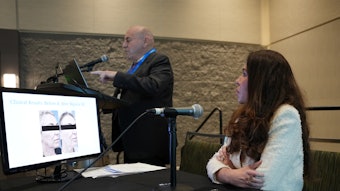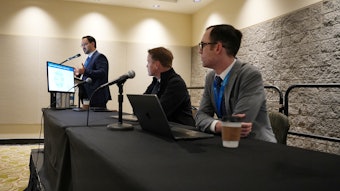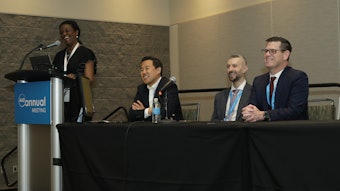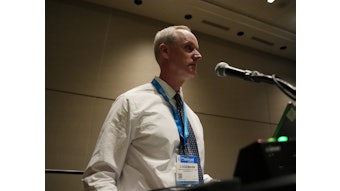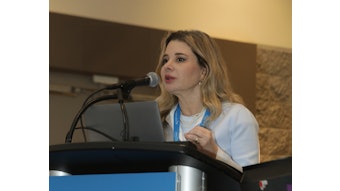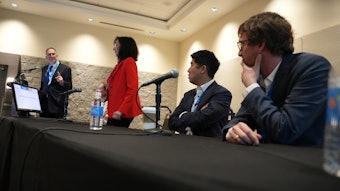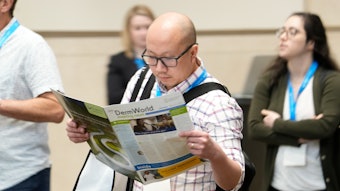A journey of impact, inspiration
Pearl E. Grimes, MD, FAAD, capped off the 2025 Annual Meeting Plenary with a dedication to science and service.

Pearl E. Grimes, MD, FAAD, channeled her predecessor and mentor during Sunday’s Plenary session when she delivered his namesake John Kenney Jr., MD, Lifetime Achievement Award and Lectureship. She reminded attendees of Dr. Kenney’s pioneering legacy as founding father of ethnic dermatology.
Dr. Grimes is director of the Vitiligo & Pigmentation Institute of Southern California, clinical professor of dermatology at UCLA, and president of the Global Vitiligo Foundation.
Her presentation, “Vitiligo: A 45-Year Journey of Science and Service,” focused on how far the specialty has come in furthering its knowledge, treatment, and management of the condition. In the early years, circa 1980, she said vitiligo was thought to be a cosmetic disease with an unknown cause. Therapies — topical, oral, UV, and otherwise — were trial and error. But always at the back of everyone’s mind was the question: How is the immune system involved?
“We really have moved far in the journey with 45 years of dedicated research,” she said. “We’ve significantly advanced our understanding of pathogenesis of vitiligo and melanocyte production. We also better understand the burden of vitiligo and published a paper titled, ‘White Patches and Bruised Souls.’ We found the burden [of vitiligo] is enormous, with physical, emotional, and mental repercussions.”
Progress over perfection
Since that paper in 2004, Dr. Grimes said researchers have identified the three contributors to vitiligo: genetics, oxidative stress, and autoimmunity. The damage goes beyond melanocytes to keratinocytes, which maintain an “ongoing dialogue” to form, protect, and pigment the skin.
Further learning has revealed that fibroblasts are a key player in destroying melanocytes and mitochondrial dysfunction occurs as a result of calcium influx, ROS overproduction, and abnormal levels of SIRT 3.
“AhR [aryl hydrocarbon receptor] is a major activate of nrf2 [nuclear erythroid 2-related factor], which is the critical pathway that helps protect oxidative stress and regulate immune response,” Dr. Grimes explained. Global studies and analyses have also found vitamin D levels to be routinely low in patients who have vitiligo.
“The take-home message from this data is that as we move forward, we have new treatments targeting not just one pathway, but multiple pathways,” she said.
Combination is key
Dr. Grimes was thrilled to report that vitiligo therapies have advanced in strides, with combination therapies, particularly narrowband ultraviolet B (NB-UVB), demonstrating superior outcomes. She also anticipates forthcoming FDA approval of three oral JAK inhibitors — ritlecitinib, baricitinib, and tofacitinib — to use in combination with phototherapy.
Now that there is a significant warehouse of demographic and lab data of vitiligo patients, maintained by the Vitiligo & Pigmentation Institute, Dr. Grimes said she hopes to be able to answer even more questions about the pathogenesis, epidemiology, and treatment of vitiligo. One new initiative with this mission at its core is the Legacy Project.
Giving back is good
Not to be forgotten is the service component of treating patients. Dr. Grimes highlighted several avenues in which she gives back to her patients and their families, who also shoulder the burden of disease: UNITE, a worldwide virtual support group that launched in December 2024; Camp Victory, an encounter for children with the condition and their parents; and CARRY, a local coalition that provides pro-bono dermatology services, as well as instruction in leadership and etiquette to at-risk youths to enhance self-esteem and restore self-worth.
“I think we really have made major strides and substantial discoveries and innovations that will forever change the landscape of vitiligo,” she said. “My passion, my dedication, and my work continue, and I thank Dr. Kenney for long ago seeing things in me that I never would have seen in myself. I never would have been here without him.”
